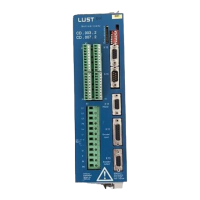Verstärkermodul / Amplifier Module
CD_..1 / CD_..2
Nr. / No.: 181-00383
60 01.2003
Mit Betätigung der HLA-Freigabe wird nun der
Sprung ausgelöst. Stromsoll- und Stromistwert
sollen den gleichen Verlauf haben.
Die Parameter sind nun so zu variieren, daß der
gewünschte Verlauf annähernd erreicht wird.
Dafür gilt die Faustformel:
§ Vergrößern von v
p
und Verkleinern von
T
n
macht den Regler schneller.
§ Je schneller der Regler ist, desto eher neigt er
zum (Über-)Schwingen.
Der Wirkstrom-Sollwert kann noch geglättet
werden (4.2.2.7.3). Dazu kann eine Zeitkonstante
für den Tiefpaß eingegeben werden (0-9.99ms)
Drehzahlregler 4.2.2.6.1(2) und 4.2.2.4.1
Mit den Parametern v
pn
(4.2.2.6.1 (0.01-1.00)) und
T
nn
(4.2.2.6.2 (0.1- 50ms)) läßt sich der
Drehzahlregler optimieren.
Es gelten die gleichen Aussagen wie für den
Stromregler (Parameter v
pi
und T
ni
), d.h. der
Drehzahlregler wird auch über seine
Sprungantwort optimiert.
Die Monitore sind mit den entsprechenden
Drehzahlwerten zu belegen,
− Monitor 1 mit dem Drehzahlsollwert (3.5.1)
und
− Monitor 2 mit dem Drehzahlistwert (3.6.2).
Bei der Drehzahlregelung ist häufig ein
Kompromiß zwischen der Dynamik und der
Rundlaufgüte erforderlich. Mit Hilfe der Glättung
des Drehzahlistwertes (4.2.2.4.1) steht dafür ein
weiterer Parameter zur Verfügung (0.00-
99.99ms).
Bei großen Maschinen kann diese Zeitkonstante
vergrößert werden, ohne daß, bei gleichzeitiger
Verbesserung der Rundlaufgüte, dies einen
Einfluß auf die Dynamik hat.
Grundsätzlich sollte die Zeitkonstante so klein wie
möglich gewählt werden.
By actuation of the HLA-enable the jump is released.
Current setpoint and actual current shall have the same
course.
Now vary the parameters in such a way that the required
course is reached approximately. Here the thumb rule
applies:
• increase of v
p
and reduction of T
n
accelerate the regulator
• the quicker the regulator the more tendency
to (over-) shooting
The active current setpoint can still be smoothed
(4.2.2.7.3). To that effect input a time constant for the
low-pass filter (0-9.99 ms).
Speed regulator 4.2.2.6.1 (2) and 4.2.2.4.1
The speed regulator can be optimized by the parameters
v
pn
(4.2.2.6.1 (0.01-1.00)) and T
nn
(4.2.2.6.2 (0.1-50
ms)).
The same instructions as to the current regulator apply
(v
pi
and T
ni
), i.e. the speed regulator as well is
optimized through its jump reaction.
Provide the monitors with the corresponding speed
values,
-- monitor 1 with speed setpoint (3.5.1) and
-- monitor 2 with actual speed (3.6.2).
The speed regulation often requires a compromise
between the dynamics and the concentricity. By means
of actual speed smoothing (4.2.2.4.1) another parameter
(0.00-9.99 ms) is available for this duty.
With large machines this time constant can be increased
without influencing the dynamics, whereas
simultaneously the concentricity is improved.
On principle the time constant shall be selected as low
as possible.

